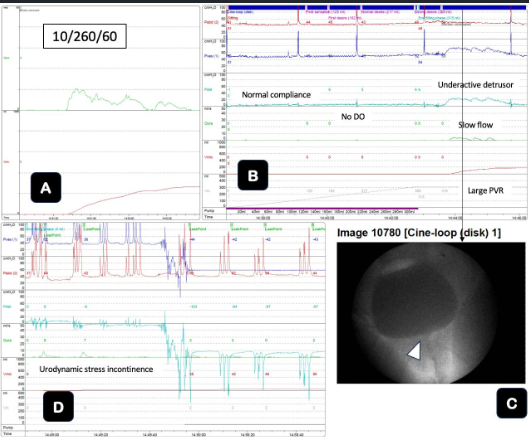




Figure 1.
Urodynamic stress incontinence with underactive detrusor in a 52-year-old obese woman with bothersome stress incontinence and mild voiding difficulty. No underlying neurological condition.
1A. Slow flow with an abnormal pattern. Maximum flow rate ten mL/s, voided volume 260ml with 60 ml residual urine. The flow was representative.
1B. Urodynamic study showing normal capacity, normal compliance, early sensations, but no detrusor overactivity. Voiding pressure flow study showed an underactive detrusor (ICS-DCI 42, PIP1 26)1
1C. Video-urodynamics view during voiding shows bladder neck opening well (Arrowhead). Normal bladder morphology and no reflux are consistent with the lack of an underlying neurological condition.
1D. Urodynamic stress incontinence noted both with and without a urethral catheter both in the sitting and standing position with abdominal leak point pressure 100 cm H20.
For women who fail initial conservative treatment, there are challenges in management, with a significant possibility that stress incontinence surgery might exacerbate voiding dysfunction and necessitate intermittent catheterization. 2, 3

References:
1. Rosier PFWM, Gammie A, Valdevenito JP, Speich J, Smith P, Sinha S; members of the ICS Working Group PFS23. ICS-SUFU standard: Theory, terms, and recommendations for pressure-flow studies performance, analysis, and reporting. Part 2: Analysis of PFS, reporting, and diagnosis. Neurourol Urodyn. 2023; 42: 1603-1627.
2. Shapiro KK, Tyagi P, Chermansky CJ. Underactive Bladder and Bladder Outlet Procedures in Women. Curr Bladder Dysfunct Rep. 2020; 15: 21-24.
3. Natale F, Illiano E, Zucchi A, Balzarro M, La Penna C, Costantini E. Transobturator mid-urethral sling in females with stress urinary incontinence and detrusor underactivity: effect on voiding phase. Int Urogynecol J. 2019; 30: 1519-1525.